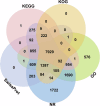A chromosome-level genome assembly of the Bullacta exarata (Cephalaspidea: Haminoeidae)
- PMID: 40523891
- PMCID: PMC12170864
- DOI: 10.1038/s41597-025-05373-2
A chromosome-level genome assembly of the Bullacta exarata (Cephalaspidea: Haminoeidae)
Abstract
The mudsnail, Bullacta exarata, is an important marine food mollusk for both economic and aquaculture purposes. However, the scarcity of genomic information has hindered genetic research and breeding efforts. To address this gap, we developed a chromosome-level genome assembly utilizing short reads, HiFi long reads, and Hi-C sequencing data. The final assembly measures 836.77 Mb, with scaffold N50 and contig N50 values of 48.61 Mb and 1.00 Mb, respectively. Using Hi-C technology, 815.25 Mb (97.43%) of the contigs were anchored and arranged into 18 pseudochromosomes. A total of 358.66 Mb was identified as repeat elements, representing 42.86% of the genome. Furthermore, we predicted 85,914 non-coding RNAs and 17,996 protein-coding genes, with 93.48% of the protein-coding genes annotated. The BUSCO analysis indicated that the completeness of the genome assembly and annotation is 94.55% and 96.65%, respectively. Phylogenetic analysis clarified the evolutionary relationships between B. exarata and representative species in gastropoda. This high-quality reference genome for B. exarata serves as a valuable resource for aquaculture, fisheries, and ecological research.
© 2025. The Author(s).
Conflict of interest statement
Competing interests: The authors declare no competing interests.
Figures





Similar articles
-
Chromosome-level genome assembly of Sinocyclocheilus jii based on PacBio HiFi and Hi-C sequencing.Sci Data. 2025 Jul 26;12(1):1303. doi: 10.1038/s41597-025-05663-9. Sci Data. 2025. PMID: 40715168 Free PMC article.
-
Chromosome-level genome assembly and annotation of Spinibarbus caldwelli.Sci Data. 2025 Jul 3;12(1):1138. doi: 10.1038/s41597-025-05469-9. Sci Data. 2025. PMID: 40610506 Free PMC article.
-
Chromosome-level genome assembly of Triplophysa scleroptera.Sci Data. 2025 Jul 1;12(1):1082. doi: 10.1038/s41597-025-05122-5. Sci Data. 2025. PMID: 40595745 Free PMC article.
-
Diagnostic test accuracy and cost-effectiveness of tests for codeletion of chromosomal arms 1p and 19q in people with glioma.Cochrane Database Syst Rev. 2022 Mar 2;3(3):CD013387. doi: 10.1002/14651858.CD013387.pub2. Cochrane Database Syst Rev. 2022. PMID: 35233774 Free PMC article.
-
Systemic pharmacological treatments for chronic plaque psoriasis: a network meta-analysis.Cochrane Database Syst Rev. 2017 Dec 22;12(12):CD011535. doi: 10.1002/14651858.CD011535.pub2. Cochrane Database Syst Rev. 2017. Update in: Cochrane Database Syst Rev. 2020 Jan 9;1:CD011535. doi: 10.1002/14651858.CD011535.pub3. PMID: 29271481 Free PMC article. Updated.
References
-
- Malaquias, M. A. E. Systematics, phylogeny, and natural history of Bullacta exarata (Philippi, 1849): an endemic cephalaspidean gastropod from the China Sea. J. Nat. Hist.44, 2015–2029 (2010).
-
- Ge, B. M., Bao, Y. X. & Cheng, H. Y. Tempo-spatial variation of macrobenthic communities on a tidal flat of Wenzhou Bay, China. Rev. Biol. Marina Y Oceanogr.46, 281–286 (2011).
-
- Liu, J. et al. Epizoic Ulva attached to intertidal animals in the Subei intertidal zone are not the additional source of the famed Yellow Sea green tides. J. Sea Res.174, 102065 (2021).
-
- Ge, B. M., Bao, Y. X., Cheng, H. Y., Zhang, D. Z. & Tang, B. P. Temporal and spatial distribution pattern of Bullacta exarata in a tidal flat at south shore of Hangzhou Bay, China. Iran. J. Fish. Sci. 12, 96–104.
Publication types
MeSH terms
Grants and funding
LinkOut - more resources
Full Text Sources
Miscellaneous

